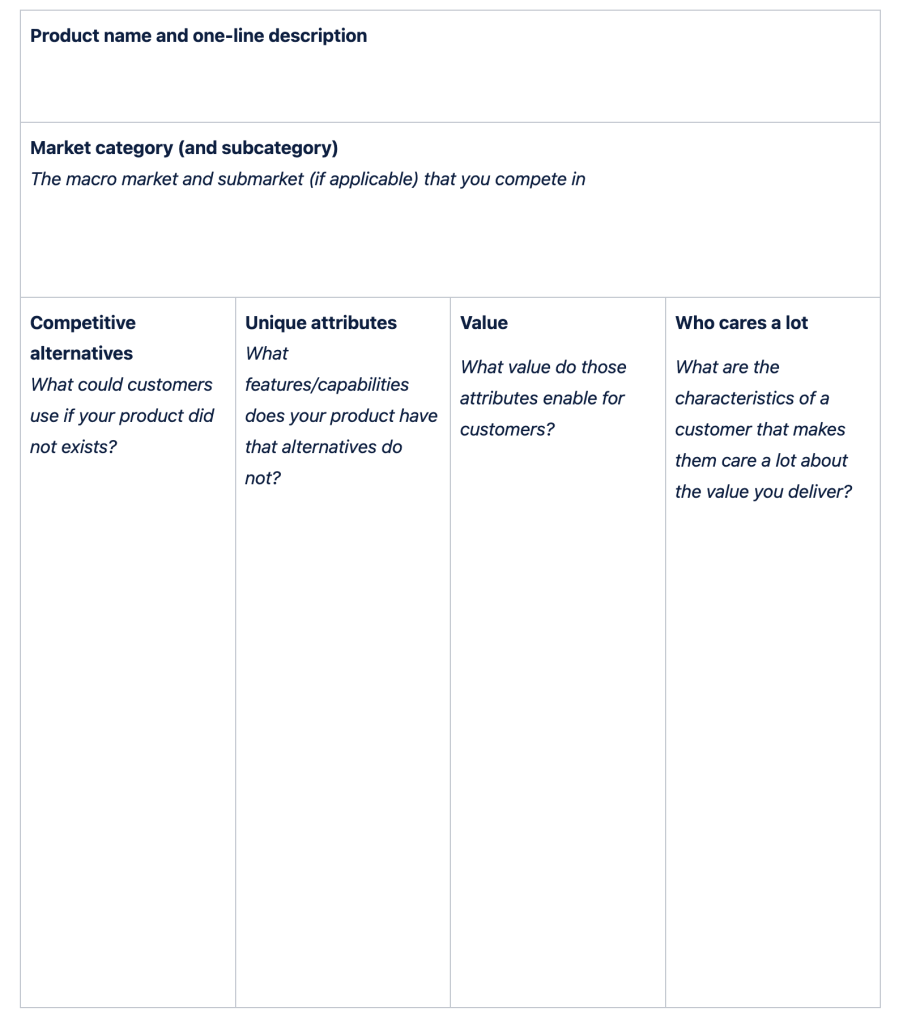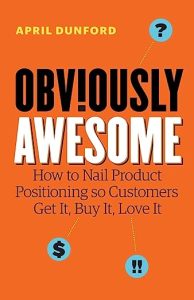Lately I have become interested in product marketing. My work at Carrot combined with my desire to grow copypress.ai has led me to realize product marketing is difficult.
Unlike other roles – product marketing is the cross between 3-4 different teams, so not only do you need to be excellent at collaboration but you need to realize decisions you make have upstream and downstream effects.
Obviously Awesome is a highly recommend book on positioning which is a critical aspect of product marketing. April Dunford suggests, “positioning is the act of deliberately defining how you are the best at something that a defined market cares a lot about.” – pg.4
I am going to layout some of the biggest insights I gather from reading Obviously Awesome.
Here is a positioning canvas that I found to be a concise encapsulation of her entire book

Product positioning is all about customers ability to
- Easily understand what your product is,
- Why it’s special
- Why it matters to them
Context Setting
I noticed a majority of Dunford’s thoughts on positioning center around the idea that customers will place your product in a perceived category based on how you frame the product.
When customers encounter a product they have never seen before, they will look for contextual clues to help them figure out what it is, who it’s for and why they should care. This incorporates all parts of product marketing from your brand, messaging, pricing, features, and partners/testimonials.
As product creators, we need to understand that the choices we make in positioning and context can have a massive impact on our businesses—for better or worse.
pg.27
Two Traps To Avoid
Trap #1: You are stuck on the idea of what you intended to build, and you don’t realize that your produce has becoming something else.
Solution: Listen to customers and be ready to pivot based on feedback and market conditions.
Trap #2: You carefully designed your product for a market, but that market has changed.
Solution: Be aware of trends and market shifts. Examples include health trends, cybersecurity, legal regulations, work from home policies and more.
The 5 Components Of Effective Positioning
- Competitive alternatives. What customers would do if your solution didn’t exist.
- Unique attributes. The features and capabilities that you have and the alternatives lack.
- Value (and proof). The benefit that those features enable for customers.
- Target market characteristics. The characteristics of a group of buyers that lead them to really care a lot about the value you deliver.
- Market category. The market you describe yourself as being part of, to help customers understand your value. (
- Bonus – Relevant trends. Trends that your target customersunderstand and/or are interested in that can help make your product more relevant right now.
The 10 Step Positioning Process
Step 1 – Understand the customers who love your product
They understood your product quickly and bought from you quickly. They became raving fans, referred you to other companies and acted as a reference for you.
One way I am thinking about this is who accelerated through your customer journey will little help?
How fast did a customer sign up and become an advocate?
Where did they come from? What problems were they trying to solve?
Step 2 – Form a positioning team
The positioning process works best when it’s a team effort, ideally from across different functions within the company. Each team, from sales to marketing to customer success can bring a unique point of view relative to how customers perceive and experience the product.
Step 3 – Align your positioning vocabulary and let go of your positioning baggage
In order to consider possible new ways to think about a product, we have to consciously set aside our old ways of thinking about it. To do that, we need a common positioning vocabulary. At a minimum the team needs to be on the same page with
- What positioning means and why it’s important
- Which components make up positioning and how we define each of those
- How market maturity and competitive landscape impact the style of positioning you choose for a product.
In this section it outlines how important it is for everyone to agree what features are actually valuable and quantifiable to the customer. Everyone wants to claim they have “great support” but how do you know how that stacks up in the market objectively?
Step 4 – List your true competitive alternatives
Customers don’t always see competitors the same way we do, and their opinion is the only one that matters for positioning.
👍 Best practices
- Keep the list between 3-5 products/companies
- Understand what your best-fit customers would replace you with
- Group your potential alternatives (do it myself, hire it out, etc.)
Step 5 – Isolate your unique attributes or features
Strong positioning is centered on what a product does best. Once you have a list of competitive alternatives, the next step is to isolate what makes you different and better than those alternatives.
In this step, list all of the capabilities you have that the alternatives do not. Next you need to objectively weigh them against alternatives.
You opinions of your own strengths is irrelevant without proof.
Focus on “consideration” rather than “retention” attributes. The way to think about this is features that bring someone INTO the software and NOT what KEEPS them there. Positioning works best when it attracts people so they have the CHANCE to fully experience the positioning promise.
Step 6 – Map the attributes to value themes
- Feature: something your product does or has
- Benefit: What the feature enables for customers
- Value: How this feature maps to a goal the customer is trying to achieve
Write down your features, and translate them into benefits and value and then group them into themes.
Example of themes could be – supports remote environments (wifi enabled, offline editing, etc).
Step 7 – Determine who cares a lot
Once you have a good understanding of the value that your product delivers versus other alternatives, you can look at which customers really care a lot about the value.
An actionable segmentation captures a list of persona’s or company’s easily identifiable characteristics that make them really care about what you do.
Examples for consumer goods…
- Brands they own
- Stores they like
- Stores they buy from
- Job they hold
- Music preferences
- Etc.
Target as narrowly as you can to meet your near-term sales objectives. You can broaden the targets later.
Step 8 – Find a market frame of reference that puts your strengths at the center and determine how to position in it
You now have a good handle on your ideal prospects, your product’s unique attributes and the value those attributes can deliver. The next step is to pick a market frame of reference that makes your value obvious to the segments who care the most about the value.
Different approaches to finding a winning market
- Head to head: positioning to win an existing market
- Big fish, small pond: positioning to win a subsegment of an existing market
- Create a new game: positioning to win a market you create
The hardest of these 3 strategies is creating a new game. Usually you need a new technology or innovative way to solve a big problem. Each of these have a unique set of pros and cons and you aren’t “stuck” in any of these modes.
Step 9 – Layer on a trend (but be careful)
Once you have determined your market context, you can start to think about how you can layer a trend on top of your positioning to help potential customers understand why your offering is important to them right now. This step is optional but potentially very powerful.
The risk you run here is the trend confusing your positioning more than helping it.
We saw this with the rise in blockchain where companies were claiming to use the technology but it was unclear why, how and where so it didn’t support the positioning.
The way I think about this is if the trend’s value is easy to explain or display in 10 seconds or less – it’s worth investing in and adding to your positioning.
Step 10 – Capture your positioning so it can be shared
Positioning on its own isn’t useful to a company. Once you have worked through your positioning, you need to share it across the organization. Positioning needs to have company buy-in so it can be used to inform…
- Branding,
- Marketing campaigns
- Sales strategy
- Product decisions
- Customer success strategy.

Next Steps
Once you have positioning in place you need to take it into some specific areas of the business.
- Create a sales story
- Create messaging guidelines so your product is using the positioning correctly
- Product roadmap and pricing – based on attributes and competitive alternatives
- Track your positioning over time – it can change as markets and customer sentiment/needs change
If you want success, be unique
Natalie Massenet
Join The Newsletter
Get occasional emails from me when I publish new projects and articles.
